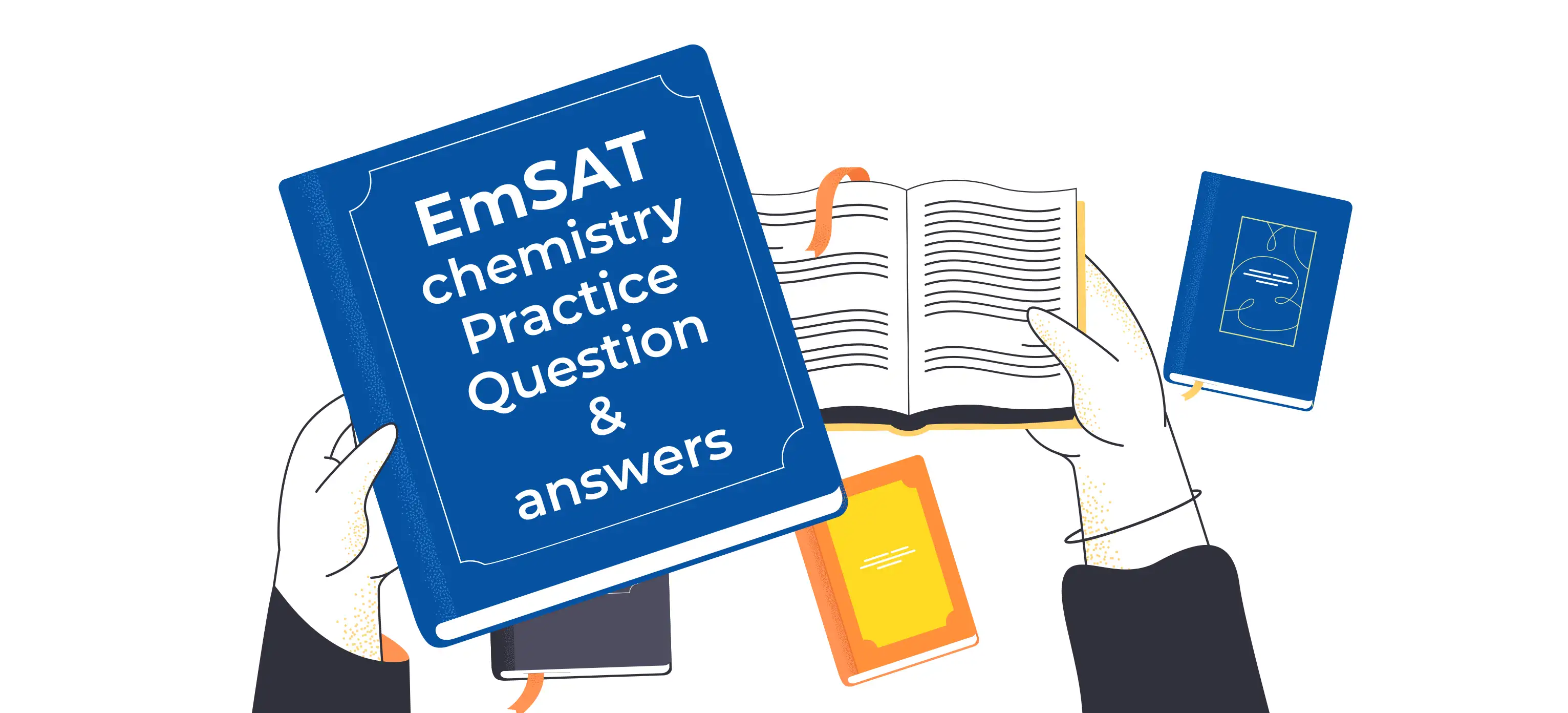
The EmSAT Achieve Chemistry test measures the readiness of a test taker to study chemistry at a college or university. It is a computer-based exam with randomized sections, questions, and options. The tests are timed by the computer. Test-takers can see how much time they have throughout the exam.
| Test duration: | 90 minutes |
| Questions: | 50 questions |
| Content Areas: | Matter and its properties Energy, force, and conservation |
| Task Types: | Multiple Choice, Multi-select, Fill-in-the-Blank, and Drag and Drop |
EmSAT Achieve Chemistry is a new assessment test for high school students in the UAE. The test measures student achievement in Chemistry and is aligned with the UAE's National Curriculum. EmSAT Achieve Chemistry is offered in both English and Arabic and is administered by the Ministry of Education.
The test is available to all high school students in the UAE and will be offered twice per year. EmSAT Achieve Chemistry is an important new assessment tool that will help to improve student achievement in Chemistry and ensure that all students have the knowledge and skills necessary to succeed in higher education and beyond.
| Score | Descriptors |
| 1500+ | Demonstrates comprehensive knowledge in general Chemistry. Understands related concepts, laws, and principles. Evaluates quantitative and qualitative data thoroughly. Understands complex models and make appropriate predictions. Solves most quantitative and qualitative problems skillfully. |
| 1300 – 1475 | Demonstrates very broad knowledge in general Chemistry. Understands related concepts, laws, and principles. Very competently evaluates quantitative and qualitative data. Solves familiar problems and most new quantitative and qualitative problems. |
| 1100 – 1275 | Demonstrates broad knowledge in general Chemistry. Shows sound understanding of most concepts and apply them in some contexts. Analyzes quantitative and qualitative data competently. Solves most basic and familiar problems and some new problems. |
| 900 – 1075 | Demonstrates reasonable knowledge in general Chemistry. Shows adequate comprehension of most basic concepts but with limited ability to apply them. Demonstrates some analysis or evaluation of quantitative and qualitative data. Solves some basic or routine problems but shows limited ability to deal with new or difficult situations. |
| 700 – 875 | Demonstrates limited knowledge in general Chemistry. Shows a partial comprehension of basic concepts but a weak ability to apply them. Shows some ability to manipulate data and solve basic or routine problems. |
| 500 – 675 | Demonstrates little knowledge in general Chemistry. Shows weak comprehension of basic concepts with little evidence of application. Has minimal ability to manipulate data and little ability to solve problems. |
| < 500 | Demonstrates almost no knowledge in general Chemistry. Shows no or very weak understanding of any concepts or principles. Gives responses that are mostly incomplete or unrelated. |
Appendix 1
Content Area 1: Matter and its properties (55% – 65%)
Content Area 2: Energy, force and conservation (35% – 45%)
The EmSAT is a standardized test that assesses your knowledge of chemistry concepts. While the test is not required for admission to most colleges, it can give you an edge over other applicants. Here are some tips on how to prepare for the EmSAT chemistry test:
The EMSAT Chemistry Practice Test With Answers is a great way to prepare for your EMSAT Chemistry exam. The practice test covers all the topics covered on the EMSAT Chemistry exam, and it provides you with an opportunity to test your knowledge and skills.
Given below is a sample of EmSAT chemistry practice test questions with answers.
1. Silicon has an atomic number of 14 and its electronic configuration is 1s22s22p63s23p2.Aluminium has an atomic number of 13. What is aluminium's electronic configuration?
● A. 1s22s22p63s23p2
● B. 1s22s22p63s23p4
● C. 1s22s22p63s23p1
● D. 1s22s22p63s23p3
2. -The volume of a gas is inversely proportional to its pressure, if the number of gas particles and temperature are constant.' This is a description of:
● A. boyle's law
● B. Charles' law
● C. Newton's law
● D. Faraday's law
3. A student is using the alkali KOH(aq) to neutralize the acid HNO3(aq)
. 50 ml of 50 mM of KOH(aq) is required to neutralize 25 ml of HNO3(aq). What is the concentration of the HNO3(aq) in mM?
● A. 50 mM
● B. 100 mM
● C. 200 mM
● D. 300 mM
4. A liquid contains a solute that does not separate out. This liquid can be poured through a filter unchanged and this liquid allows light to pass through it clearly. This liquid is a:
● A. Solution
● B. Suspension
● C. Colloid
● D. Solid
5. Sodium chloride has a mass of 58.44 g per mole. How many grams of sodium chloride must be completely dissolved in a 500 ml of water to make a 1 molar solution?
● A. 116.88 g
● B. 58.44 g
● C. 29.22 g
● D. 14.61 g
6. Which of the following processes is an example of deposition?
● A. Liquid to solid - freezing water on a cold day
● B. Solid to gas - iodine solid to iodine vapour.
● C. Gas to solid - water vapour forming frost on a cold window
● D. Liquid to gas - water to steam (water vapour).
7. Which subatomic particle has the smallest mass?
● A. Electron
● B. Proton
● C. Neutron
● D. Alpha particle
8. At 25°C, an aqueous solution of a 1M CH₃COOH tested using a universal indicator shows that the pH is 5. This solution is:
● A. Basic
● B. Alkaline
● C. Acidic
● D. Neutral
NaCI(aq) + AgNO3(aq) → NaNO3(aq) + AgCI(S)
9. The reaction above is an example of a:
● A. Direct combination / synthesis reaction
● B. Single displacement reaction
● C. Double displacement reaction
● D. Decomposition reaction
10. The half-life of C-14 (Carbon-14) is 5,700 years. If an ancient wooden weapon has a C-14 content of only 25% of modem wood, how old is the ancient wooden weapon?
● A. 2,850 years
● B. 5,700 years
● C. 8,550 years
● D. 11.400 years
11. An alloy is a
● A. Mixture
● B. Non-metal
● C. Compound
● D. Gas
12. Which item in the redox reaction below becomes oxidized?
HgCl2(aq) + Sn2+(aq) → Sn4+(aq) + HgCl2(aq)+ Cl- (aq)
● A. HgCl2
● B. Hg2Cl2
● C. Sn2+
● D. Sn4+
13. Which statement about chemical equilibria is incorrect?
● A. At equilibrium the forward reaction rate equals and balances the reverse reaction rate.
● B. The stable equilibrium state can be reached starling with either reactants or products.
● C. At equilibrium, the concentration of reactants and products remain constant.
● D. Chemical equilibrium can only be reached by starting with substances on the reactant side of the equation.
14. Which of the graphs below showing the energy change during chemical reactions, displays the moss exothermic reaction?
(R = reactants. P = products: the ordinate/vertical axis measures energy/enthalpy. the abscissa/ horizontal axis represents time).
● A. A
● B. B
● C. C
● D. D
15. What is the correct equilibrium constant expression (Keq) for the reaction below?
● A. Keq = [H2O]2 * [Cl2] / [HCl]4 * [O2]
● B. Keq = [H2O] * [Cl2] / [HCl] * [O2]
● C. Keq = 2[H2O] * [Cl2] / 4[HCl] * [O2]
● D. Keq = [HCl] * [O2] / [H2O] * [Cl2]
16. Which of the following solutions of sodium chloride at 25°C contains the most of this ionic solute?
● A. An unsaturated solution
● B. A saturated solution
● C. A supersaturated solution.
● D. Pure water.
17. Which of the following reactions shows the oxidation of Ti2+ ?
● A. Ti => Ti2++ 2e-
● B. Ti3+ + e- => Ti2+
● C. Ti2+ + 2e- => Ti
● D. Ti2+ => Ti3++ e-
18. What kind of compound is shown above?
● A.Halocarbon
● B. Ester
● C. Alcohol
● D. Carboxylic acid
19. Considering the nuclear reaction below in which X represents the nuclide product:
Which of the answer options is the nuclide X?
● A.23592U
● B. 23194Pu
● C. 23993Np
● D. 23994Pu
20.

21
22
23
24
25
Here is the list of other major locations where Edoxi offers EmSAT Chemistry Training

English Language and Soft Skills Trainer
Ms. Shereen Backer is a broad minded English language and Soft Skills trainer with Edoxi Training Institute, Dubai. She is fascinated about training young minds and professionals to reach new heights in their career. Her vast experience as an English language and soft skills trainer enables her to handle training sessions for students from diverse cultures.
Ms. Shereen challenges her students to be the best version of themselves. She holds strong records of accomplishment with TESOL/TEFL Certification and IDP Teacher’s Training Program Accreditation.
For the last seven years, she has been working with companies and universities as an ESL/EFL verbal trainer cum academic and career counsellor. She helped more than 500 individuals to clear exams like IELTS, PTE, TOEFL, OET, DET, PSAT, NMSQT and SAT. She also specialises in voice and accent training for English language students.
